Arizona
state, United States
Introduction
Arizona, flag of
 constituent state of the United States of America (United States). Arizona is the sixth largest state in the country in terms of area. Its population has always been predominantly urban, particularly since the mid-20th century, when urban and suburban areas began growing rapidly at the expense of the countryside. Some scholars believe that the state's name comes from a Basque phrase meaning “place of oaks,” while others attribute it to a Tohono O'odham (Papago) Indian phrase meaning “place of the young (or little) spring.” Arizona achieved statehood on Feb. 14, 1912, the last of the 48 coterminous United States to be admitted to the Union.
constituent state of the United States of America (United States). Arizona is the sixth largest state in the country in terms of area. Its population has always been predominantly urban, particularly since the mid-20th century, when urban and suburban areas began growing rapidly at the expense of the countryside. Some scholars believe that the state's name comes from a Basque phrase meaning “place of oaks,” while others attribute it to a Tohono O'odham (Papago) Indian phrase meaning “place of the young (or little) spring.” Arizona achieved statehood on Feb. 14, 1912, the last of the 48 coterminous United States to be admitted to the Union.

 constituent state of the United States of America (United States). Arizona is the sixth largest state in the country in terms of area. Its population has always been predominantly urban, particularly since the mid-20th century, when urban and suburban areas began growing rapidly at the expense of the countryside. Some scholars believe that the state's name comes from a Basque phrase meaning “place of oaks,” while others attribute it to a Tohono O'odham (Papago) Indian phrase meaning “place of the young (or little) spring.” Arizona achieved statehood on Feb. 14, 1912, the last of the 48 coterminous United States to be admitted to the Union.
constituent state of the United States of America (United States). Arizona is the sixth largest state in the country in terms of area. Its population has always been predominantly urban, particularly since the mid-20th century, when urban and suburban areas began growing rapidly at the expense of the countryside. Some scholars believe that the state's name comes from a Basque phrase meaning “place of oaks,” while others attribute it to a Tohono O'odham (Papago) Indian phrase meaning “place of the young (or little) spring.” Arizona achieved statehood on Feb. 14, 1912, the last of the 48 coterminous United States to be admitted to the Union.
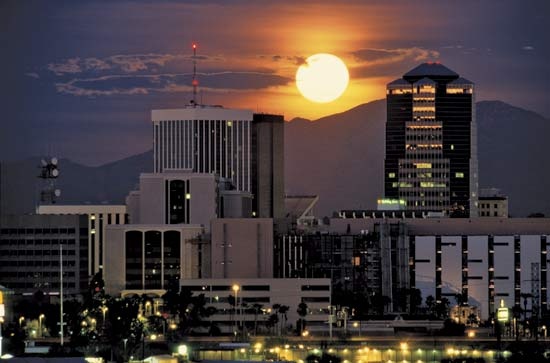 Arizona is a land of contradictions. Although widely reputed for its hot, low-elevation desert covered with cacti and creosote bushes, more than half of the state lies at an elevation of at least 4,000 feet (1,200 metres) above sea level, and it possesses the largest stand of evergreen ponderosa pine trees in the world. Arizona is well known for its waterless tracts of desert, but, thanks to many large man-made lakes, it has many more miles of shoreline than its reputation might suggest. Such spectacular landforms as the Grand Canyon and the Painted Desert have become international symbols of the region's ruggedness, yet Arizona's environment is so delicate that in many ways it is more threatened by pollution than are New York City and Los Angeles. Its romantic reputation as a wild desert and a place of old-fashioned, close-to-the-earth simplicity is at variance with the fact that after the 1860s the state's economy became industrial and technological long before it was pastoral or agrarian.
Arizona is a land of contradictions. Although widely reputed for its hot, low-elevation desert covered with cacti and creosote bushes, more than half of the state lies at an elevation of at least 4,000 feet (1,200 metres) above sea level, and it possesses the largest stand of evergreen ponderosa pine trees in the world. Arizona is well known for its waterless tracts of desert, but, thanks to many large man-made lakes, it has many more miles of shoreline than its reputation might suggest. Such spectacular landforms as the Grand Canyon and the Painted Desert have become international symbols of the region's ruggedness, yet Arizona's environment is so delicate that in many ways it is more threatened by pollution than are New York City and Los Angeles. Its romantic reputation as a wild desert and a place of old-fashioned, close-to-the-earth simplicity is at variance with the fact that after the 1860s the state's economy became industrial and technological long before it was pastoral or agrarian.Arizona is located in the southwestern quadrant of the coterminous states, bordered by California to the west, Nevada to the northwest, Utah to the north, New Mexico to the east, and the Mexican state of Sonora to the south. The Colorado River forms the boundary with California and Nevada. Phoenix, situated in the south-central part of the state, is the capital and largest city. Area 113,999 square miles (295,256 square km). Pop. (2000) 5,130,632; (2007 est.) 6,338,755.
Land (Arizona)
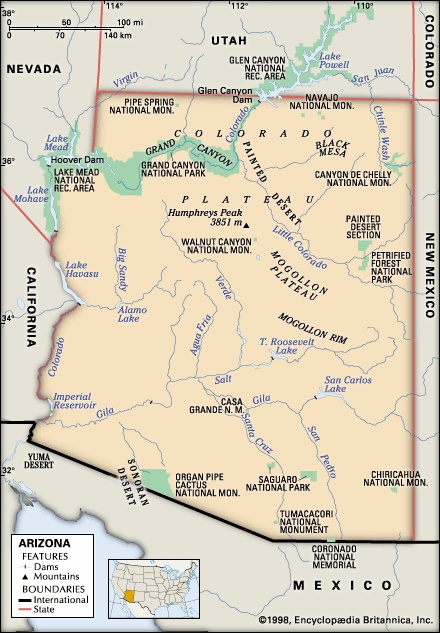
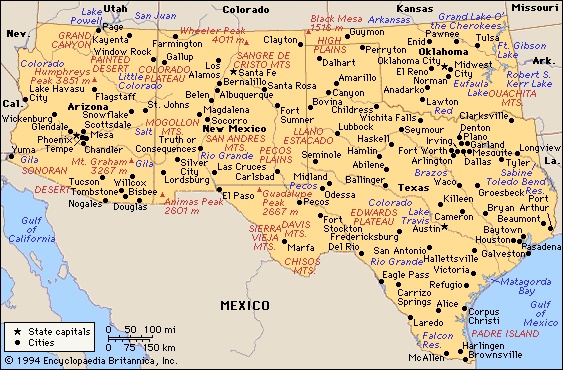 Plate tectonics—the shifting of large, relatively thin segments of the Earth's crust—and stream erosion have done the most to create Arizona's spectacular topography. Specifically, the Pacific Plate and the North American Plate came into contact and created the major tectonic forces that uplifted, wrinkled, and stretched Arizona's geologic crust, forming its mountain ranges, basins, and high plateaus. Over the course of millennia, rivers and their tributaries have carved distinctive landforms on these surfaces.
Plate tectonics—the shifting of large, relatively thin segments of the Earth's crust—and stream erosion have done the most to create Arizona's spectacular topography. Specifically, the Pacific Plate and the North American Plate came into contact and created the major tectonic forces that uplifted, wrinkled, and stretched Arizona's geologic crust, forming its mountain ranges, basins, and high plateaus. Over the course of millennia, rivers and their tributaries have carved distinctive landforms on these surfaces.Relief
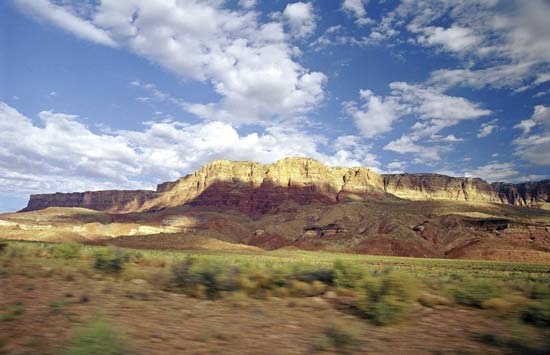 To Arizona's two major physiographic divisions, the Colorado Plateau and the Basin and Range Province, geologists add the Transition Zone (or Central Highlands). The northeastern two-fifths of Arizona is part of the scenic Colorado Plateau. Far less rugged than adjacent portions of the plateau in Utah, these tablelands in Arizona consist mainly of plains interrupted by steplike escarpments. Although they are labeled mesas and plateaus, their ruggedness and inaccessibility have been exaggerated. The incomparable Grand Canyon of the Colorado River provides the major exception to what has proved to be an area easily traversed. Forest-clad volcanic mountains atop the plateaus provide the state's highest points: Humphreys Peak, 12,633 feet (3,851 metres), in the San Francisco Mountains, and Baldy Mountain, 11,403 feet (3,476 metres), in the White Mountains.
To Arizona's two major physiographic divisions, the Colorado Plateau and the Basin and Range Province, geologists add the Transition Zone (or Central Highlands). The northeastern two-fifths of Arizona is part of the scenic Colorado Plateau. Far less rugged than adjacent portions of the plateau in Utah, these tablelands in Arizona consist mainly of plains interrupted by steplike escarpments. Although they are labeled mesas and plateaus, their ruggedness and inaccessibility have been exaggerated. The incomparable Grand Canyon of the Colorado River provides the major exception to what has proved to be an area easily traversed. Forest-clad volcanic mountains atop the plateaus provide the state's highest points: Humphreys Peak, 12,633 feet (3,851 metres), in the San Francisco Mountains, and Baldy Mountain, 11,403 feet (3,476 metres), in the White Mountains.More than 200 miles (320 km) of the southern border of the Colorado Plateau is marked by a series of giant escarpments known collectively as the Mogollon Rim. West and south of the rim, a number of streams follow narrow canyons or broad valleys south through the Transition Zone and into the Basin and Range Province. The Transition Zone bordering the plateaus comprises separated plateau blocks, rugged peaks, and isolated rolling uplands so forbidding that they remained mostly unexplored until the late 19th century. The zone marks the ecological border between the low deserts and the forested highlands; it combines elements of both with, for example, the Spanish bayonet of the Sonoran Desert growing alongside the juniper characteristic of higher elevations.
The Basin and Range (Basin and Range Province) region of the southern and western third of the state contains the bulk of the population but none of the large canyons and mesas for which Arizona is famous. It consists largely of broad, open-ended basins or valleys of gentle slope. Isolated northwest-to-southeast–tending mountain ranges rise like islands in the desert plain.
Contrary to desert stereotypes, sand dunes are nearly nonexistent, and stony desert surfaces are seldom visible except in the far southwestern portion of the state. The younger soils of river floodplains provide the more-desirable soils for agriculture.
Drainage
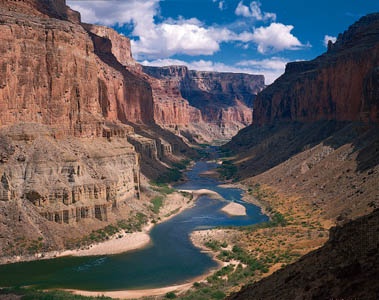 Virtually all of Arizona lies within the Colorado River drainage system. The Gila River, with its major feeder streams—the Salt (Salt River) and the Verde—is by far the Colorado's main Arizona tributary.
Virtually all of Arizona lies within the Colorado River drainage system. The Gila River, with its major feeder streams—the Salt (Salt River) and the Verde—is by far the Colorado's main Arizona tributary.The Black, White, and Verde rivers are the primary perennial tributaries of the Salt River, which enters the Gila River southwest of Phoenix. Only during the infrequent—and occasionally devastating—flood periods does runoff water advance downstream past the numerous dams built on the Salt's system. The Gila River rises in that part of the Mogollon Rim located in western New Mexico, and it includes another and smaller Mogollon Rim tributary, the San Francisco River. Two intermittent southern Arizona streams, the Santa Cruz and San Pedro rivers, flow northward into the Gila, while two other intermittent streams, the Agua Fria and Hassayampa rivers, drain central Arizona southward into the Gila. Dams and irrigation systems, except on rare occasions, leave the Gila River dry for most of its length.
The Little Colorado River—which drains the Mogollon Rim's lee side and flows from southeast to northwest into the Colorado River between Marble Canyon and the Grand Canyon—draws and transports little water from its large watershed. Because of the rain shadow effect on the Mogollon Rim's lee side, the Little Colorado usually is no more than a trickle and often is dry. Several other small and intermittent streams, such as the Bill Williams River, drain a large but arid part of western Arizona.
Climate
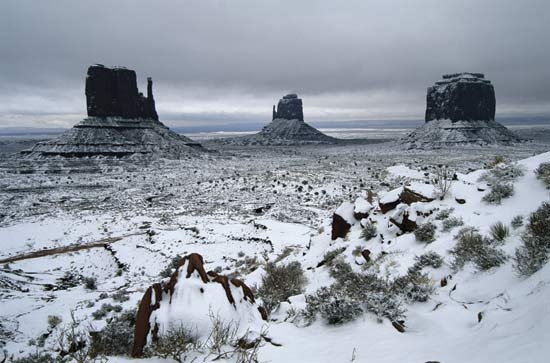 About half of Arizona is semiarid, one-third is arid, and the remainder is humid. The Basin and Range (Basin and Range Province) region has the arid and semiarid subtropical climate that attracts most winter visitors and new residents. January days in Phoenix receive more than four-fifths of the possible sunshine and have a mean maximum temperature of 65 °F (18 °C). Occasional light frosts occur at most locations in the Basin and Range region in winter, and some precipitation interrupts the exceedingly dry springs and mildly dry falls. Daily maximum readings average 106 °F (41 °C) in Phoenix in July, and nighttime temperatures drop to an average of 81 °F (27 °C).
About half of Arizona is semiarid, one-third is arid, and the remainder is humid. The Basin and Range (Basin and Range Province) region has the arid and semiarid subtropical climate that attracts most winter visitors and new residents. January days in Phoenix receive more than four-fifths of the possible sunshine and have a mean maximum temperature of 65 °F (18 °C). Occasional light frosts occur at most locations in the Basin and Range region in winter, and some precipitation interrupts the exceedingly dry springs and mildly dry falls. Daily maximum readings average 106 °F (41 °C) in Phoenix in July, and nighttime temperatures drop to an average of 81 °F (27 °C).Moisture-laden air from the Gulf of California (California, Gulf of) and the eastern Pacific Ocean appears in July, bringing more than two months of irregular but sometimes heavy thundershowers that are locally referred to as the “summer monsoon.” Phoenix and Tucson receive about 1 inch (25 mm) of precipitation in July and about 3 inches (75 mm) total throughout the summer months. Winter rains come from the Pacific.
The Colorado Plateau has cool to cold winters and a semiarid climate. Average mile-high elevations and direct exposure to polar air masses can produce January mean high and low temperatures as divergent as the 46 °F (8 °C) and 19 °F (− 7 °C), respectively, in Winslow. Year-round temperatures in Flagstaff are generally 30 °F (17 °C) cooler than those of Phoenix. Most of the region receives from 10 to 15 inches (250 to 375 mm) of precipitation annually, with the Mogollon Rim and White Mountains receiving the state's largest average, 25 inches (625 mm).
Because of the great diversity of relief within the Transition Zone, climatic conditions there vary widely over small areas. Much of Arizona's humid area lies in this zone and in the adjacent high southern edge of the Colorado Plateau. There, perennial streams flowing through shaded riparian corridors contribute to atmospheric moisture, resulting in temperatures that are several degrees cooler than those of the nearby deserts.
Plant and animal life
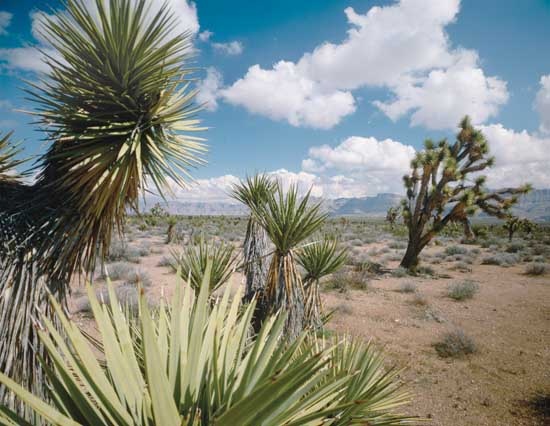
 Considering the variety in relief and climate, it is not surprising to find similar diversity in the state's vegetation. About one-tenth of Arizona is forested, one-fourth is woodland, one-fourth is grassland, and the rest is desert shrub. Elevations above 6,000 to 7,000 feet (1,800 to 2,100 metres) host forests of ponderosa pine, topped in the highest areas by Douglas and other firs, spruces, and aspen. From 4,500 to 7,500 feet (1,375 to 2,300 metres) in the northern half of the state, piñon pine and juniper predominate, while evergreen oak and chaparral grow between 4,000 and 6,000 feet (1,400 and 1,800 metres) in the central mountains. Plains grasses cover about one-third of the Colorado Plateau, and Sonoran or desert grass carpets the higher elevations of the basins. Mesquite trees have invaded many former grasslands in the south. Cacti grow throughout the state, with the greatest variety below 2,000 feet (600 metres). Foothills in the Tucson-Phoenix area carry giant saguaro cacti of the Sonoran Desert, matched in areas of the northwest Basin and Range by dramatic stands of Joshua trees. Shrubs dominate the lowest portions of all areas: big sagebrush and saltbush in the Colorado Plateau, creosote bush in the Basin and Range.
Considering the variety in relief and climate, it is not surprising to find similar diversity in the state's vegetation. About one-tenth of Arizona is forested, one-fourth is woodland, one-fourth is grassland, and the rest is desert shrub. Elevations above 6,000 to 7,000 feet (1,800 to 2,100 metres) host forests of ponderosa pine, topped in the highest areas by Douglas and other firs, spruces, and aspen. From 4,500 to 7,500 feet (1,375 to 2,300 metres) in the northern half of the state, piñon pine and juniper predominate, while evergreen oak and chaparral grow between 4,000 and 6,000 feet (1,400 and 1,800 metres) in the central mountains. Plains grasses cover about one-third of the Colorado Plateau, and Sonoran or desert grass carpets the higher elevations of the basins. Mesquite trees have invaded many former grasslands in the south. Cacti grow throughout the state, with the greatest variety below 2,000 feet (600 metres). Foothills in the Tucson-Phoenix area carry giant saguaro cacti of the Sonoran Desert, matched in areas of the northwest Basin and Range by dramatic stands of Joshua trees. Shrubs dominate the lowest portions of all areas: big sagebrush and saltbush in the Colorado Plateau, creosote bush in the Basin and Range. Animal life is even more varied, with representatives of the Rocky Mountain, Great Plains, and Mexican ecological communities. Important larger mammals are black bears, deer, desert bighorns, antelope, and wapiti (elk). The tropical coatimundi, a raccoonlike mammal, has spread northward into Arizona, while the javelina, or peccary (wild pig), is a favourite game animal in the south. Among the several cats, the bobcat and the mountain lion are most characteristic of Arizona. Coyotes, skunks, and porcupines abound, as do cottontails, jackrabbits, and several varieties of foxes. The state's southern border area lies along a major flyway and is rich in birdlife, which attracts thousands of watchers. Game birds include turkeys and a variety of quails, doves, and waterfowl. Among native fish are the Arizona trout and the Colorado squawfish. Venomous animals include rattlesnakes, scorpions, and Gila monsters.
Animal life is even more varied, with representatives of the Rocky Mountain, Great Plains, and Mexican ecological communities. Important larger mammals are black bears, deer, desert bighorns, antelope, and wapiti (elk). The tropical coatimundi, a raccoonlike mammal, has spread northward into Arizona, while the javelina, or peccary (wild pig), is a favourite game animal in the south. Among the several cats, the bobcat and the mountain lion are most characteristic of Arizona. Coyotes, skunks, and porcupines abound, as do cottontails, jackrabbits, and several varieties of foxes. The state's southern border area lies along a major flyway and is rich in birdlife, which attracts thousands of watchers. Game birds include turkeys and a variety of quails, doves, and waterfowl. Among native fish are the Arizona trout and the Colorado squawfish. Venomous animals include rattlesnakes, scorpions, and Gila monsters.People (Arizona)
Population composition
The indigenous peoples of Arizona are renowned for their rich cultural diversity. However, since the 19th century, the urbanized segments of the state have been cultural outposts that have more obviously reflected tastes, fashions, speech, religious preferences, political attitudes, and life-styles that have come from such diverse localities as Chicago, New York City, Washington, D.C., San Francisco, and Los Angeles.
Until the latter half of the 19th century, except for very small and scattered groups of indigenous peoples, almost all of central and northern Arizona remained uninhabited. Most of the Spanish occupation of the state was tentative at best and, owing to the constant danger posed by actively hostile Apache bands, remained confined to a few intermittently occupied missions, presidios, and ranches in the Santa Cruz valley, south of Tucson.
At the time of Arizona's acquisition (as part of New Mexico) by the United States in 1848, fewer than 1,000 people of Hispanic origin lived in Arizona. Not until the 20th century did the number of Hispanic residents in Arizona soar. Today most are Mexicans or descendants of Mexicans who have arrived since 1900. Relations between Mexican Americans and Anglos (a term used by Hispanics for English-speaking whites) have at times been strained in Arizona, but in general the two ethnic groups have a history of cordiality that has often been absent in other border states. While some communities have Mexican barrios (ethnic quarters, often characterized by severe poverty), most Mexican Americans in Arizona live in a variety of neighbourhoods and participate fully in the state's business, political, and social life. Intermarriage with Anglos is common. Although Mexican food, building styles, home furnishings, clothing, social customs, and music have been incorporated into the Arizona lifestyle and are widely shared by longtime residents, the great majority of people (most of whom are relative newcomers to the state from other parts of the country) have been affected by Mexican culture in only a superficial way. If anything, the Mexican American population has been attracted to mainstream American culture.
Although the Native American peoples of Arizona, since the time of the Spanish conquistadores, have been subjugated, badly exploited, and abused—much as they were elsewhere—this did not cause the total annihilation or permanent displacement of their population. The culture of Native Americans is very much in evidence in Arizona, although they constitute less than one-tenth of the total population. Native Americans are grouped into 15 tribes on 17 reservations that range in size from the 85-acre (34-hectare) Tonto Apache reserve to the 23,400-square-mile (60,600-square-km) reserve (nearly three-fifths of which lies in Arizona) of the Navajo. The latter tribe, numbering about 100,000 in Arizona, is deeply involved in directing the development of its land and people, and the tribal government assumes complete responsibility in many areas of Navajo social and economic life. Among the remaining tribes the best known are the legendary Apache and the much-studied Hopi. The Tohono O'odham and the Akimel O'odham ( Pima) peoples have also received much attention in the anthropological and historical literature. Less well known are the Havasupai, who live at the bottom of the Grand Canyon, the Hualapai, the Yaqui, and the Yavapai.
Arizona's African American population constitutes only a small proportion of the state's total. Most of Arizona's cities and towns include predominantly African American neighbourhoods, the result of de facto housing segregation. The state voluntarily desegregated its schools in the early 1940s. Asians and Pacific Islanders are growing in numbers but still constitute the smallest minorities in the state.
Settlement patterns
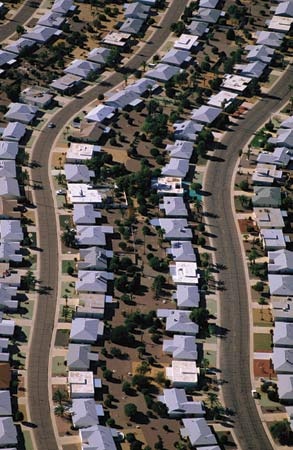
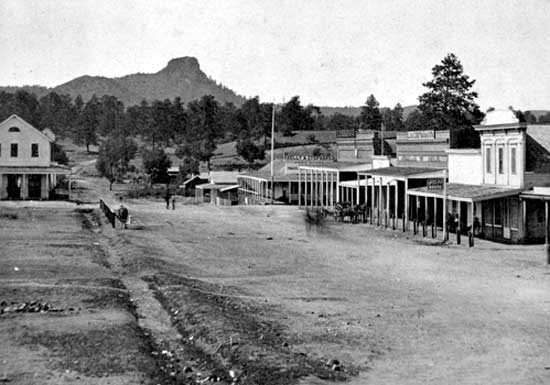 Despite Arizona's romantic image as a land of picturesque ghost towns and mining camps, isolated ranches, Native American reservations, and bucolic cotton and citrus farms, virtually all of its population is concentrated in urban areas. Three-fifths of the state's people live in just one of the state's 15 counties—Maricopa, where Phoenix is located. Of the 15 counties, 6 collectively contain four-fifths of the state's population. Only a small number of people live on farms and ranches. Most towns and cities have low population densities.
Despite Arizona's romantic image as a land of picturesque ghost towns and mining camps, isolated ranches, Native American reservations, and bucolic cotton and citrus farms, virtually all of its population is concentrated in urban areas. Three-fifths of the state's people live in just one of the state's 15 counties—Maricopa, where Phoenix is located. Of the 15 counties, 6 collectively contain four-fifths of the state's population. Only a small number of people live on farms and ranches. Most towns and cities have low population densities.Buildings of adobe can be seen in the older inhabited areas of southern Arizona, while Flagstaff and Prescott—northern Arizona cities settled by New Englanders in the 1860s and '70s—have Victorian-style houses that reflect the traditions and preferences of their first inhabitants.
Phoenix is the primary trade centre of the state. Its central location, extensive agricultural economy, and attractive vacation and retirement amenities have caused it to become one of the largest and fastest-growing urban areas in the Southwest. Tucson, while older and smaller, has acted as a doorway to Mexico and maintains well-developed commercial and medical ties with Sonora and other northern states of Mexico. Since 1970, its population growth rate has rivaled that of Phoenix.
Demographic trends
In the early 21st century Arizona's population experienced dramatic growth at almost three times the national rate. Just over a quarter of the population was under age 18. Some of the new residents, as in the past, were “snowbirds,” retirees who spend the winter in the comparatively warm desert and return to other domiciles when the weather turns hot. So-called “white flight” from California and out-migration from declining industrial areas in the Midwestern and Eastern United States accounted for many arrivals of working age. Still other newcomers were lured by opportunities in the metropolitan areas, whose economies were beginning to mature to include desirable high-paying jobs. An untold number arrived illegally, most from Mexico and Central America, and filled the ranks of the state's low-paid service and agricultural sectors. The overall population was projected to reach 10 million by the year 2027.
Economy
Before World War II the focus of Arizona's economy was primary production—mineral extraction, lumbering, cattle raising, and crop growing. Since the late 1940s the focus has shifted toward manufacturing industry and services, the economy becoming one that better represents the country's growing affluence and technology. This is especially true of the Phoenix area, where a vibrant high-technology economy has arisen.
Agriculture and livestock
Good soil, plenty of irrigation water, and a long growing season enable Arizona to produce cotton, alfalfa, and a variety of grains, vegetables, fruits, and nuts. Arizona continues to be one of the country's leading cotton producers. For many years citrus growing has remained an important and expanding part of the state's economy, and, more recently, wine producers have been successful growing a number of varietal grapes. Livestock products include beef, dairy goods, and poultry and eggs. The average size of farms in Arizona is larger than that in any other state, and farmers and ranchers use more than four-fifths of the state's water.
Resources and power
Metallic ores such as copper, zinc, and, to a modest degree, silver and gold traditionally have brought revenue to the state. Coal from the Black Mesa area of the Native American reservations in northeastern Arizona is important, since coal-fired stations generate much of the electricity for the southwestern United States; the northeastern area also produces a small amount of petroleum, as well as large quantities of uranium.
Since the 1880s, northern Arizona's massive stands of ponderosa pine have supplied a strong lumber and pulp-paper industry in the state. Rich alluvial soils, particularly in Yuma, Pinal, Pima, and Maricopa counties, have supported large and profitable agricultural operations. The state's attractive climate and landscape can also be counted among its most valuable resources.
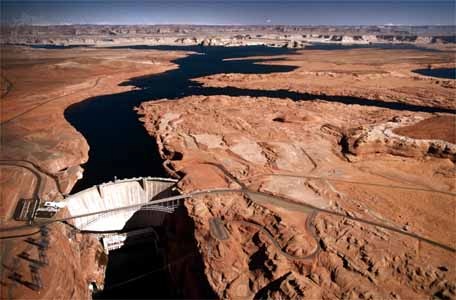 The natural geographic corridor created by the Colorado Plateau together with its Mogollon Rim escarpment has made possible Arizona's irrigation projects and most of the state's hydroelectric power, including that generated by the Roosevelt, Hoover, and Glen Canyon dams. Altogether, nearly a dozen dams control the Mogollon Rim's runoff, impounding and diverting the water to provide flood control and lakes for water storage. This hydrologic pattern has been a source of much political and legal trouble for Arizona, including years of litigation with California over rights (riparian right) to water from the Colorado River system. The state's internal sharing of water is also a major problem because groundwater has been depleted, particularly around Phoenix and Tucson, and there are no new sources of surface water. Cities have found it necessary to buy water rights from distant areas, and litigation involving municipalities, Native American tribes, and federal agencies over water rights is increasingly common.
The natural geographic corridor created by the Colorado Plateau together with its Mogollon Rim escarpment has made possible Arizona's irrigation projects and most of the state's hydroelectric power, including that generated by the Roosevelt, Hoover, and Glen Canyon dams. Altogether, nearly a dozen dams control the Mogollon Rim's runoff, impounding and diverting the water to provide flood control and lakes for water storage. This hydrologic pattern has been a source of much political and legal trouble for Arizona, including years of litigation with California over rights (riparian right) to water from the Colorado River system. The state's internal sharing of water is also a major problem because groundwater has been depleted, particularly around Phoenix and Tucson, and there are no new sources of surface water. Cities have found it necessary to buy water rights from distant areas, and litigation involving municipalities, Native American tribes, and federal agencies over water rights is increasingly common.Manufacturing
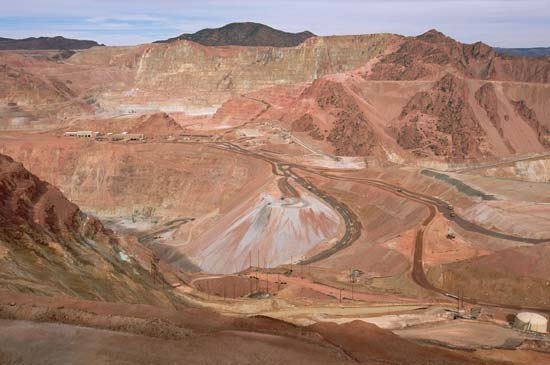 Between 1880 and 1950 the production of copper remained by far the most important industry in Arizona. Arizona is still the leading copper-producing state in the country, but manufacturing has grown to become the state's most important basic industry, notably in electronics, communications, aeronautics, and aluminum. Although this growth has brought one of the most dynamic and affluent economies in the nation, many of Arizona's outlying counties, particularly those with large Native American populations, remain among the poorest areas in the country.
Between 1880 and 1950 the production of copper remained by far the most important industry in Arizona. Arizona is still the leading copper-producing state in the country, but manufacturing has grown to become the state's most important basic industry, notably in electronics, communications, aeronautics, and aluminum. Although this growth has brought one of the most dynamic and affluent economies in the nation, many of Arizona's outlying counties, particularly those with large Native American populations, remain among the poorest areas in the country.Tourism and retirement
Urban and industrial expansion have so polluted major areas of Arizona that it no longer serves as the refuge it once did for sick people seeking pure air. The climate, scenery, and casual lifestyle, however, still attract millions of visitors each year, and the state has become a popular retirement centre, particularly in the lower desert areas. Large retirement communities such as Sun City, near Phoenix, and Green Valley, near Tucson, have continued to grow.
Transportation
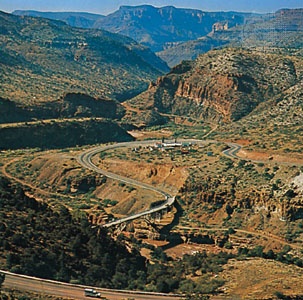 Like other western states, Arizona has not emphasized the development of mass transit systems, and state and municipal governments struggle to build sufficient roads to accommodate a swelling population. It has long been so. The state's earliest service industry was long-distance cartage over rough desert and mountain country; in modern times, the five interstate highways that pass through Arizona are crowded with heavy trucks. These highways generally follow historic roads, most of which were established along Native American trade routes and accommodated stagecoaches and freight carriers. The railroads followed in the later 19th century, with well-established east-west routes passing through southern and northern Arizona, but there was little service to the rugged interior.
Like other western states, Arizona has not emphasized the development of mass transit systems, and state and municipal governments struggle to build sufficient roads to accommodate a swelling population. It has long been so. The state's earliest service industry was long-distance cartage over rough desert and mountain country; in modern times, the five interstate highways that pass through Arizona are crowded with heavy trucks. These highways generally follow historic roads, most of which were established along Native American trade routes and accommodated stagecoaches and freight carriers. The railroads followed in the later 19th century, with well-established east-west routes passing through southern and northern Arizona, but there was little service to the rugged interior.Surface transportation is generally organized on the model of southern California, with streets on a grid pattern punctuated by freeways and highways. Within the cities some attention has been given to the development of bicycle paths. Phoenix's Sky Harbor International Airport offers nonstop international and domestic flights; Tucson International Airport provides more-limited nonstop flights; and Flagstaff and Yuma airports have fewer still. Many other towns have airports capable of accommodating small jet aircraft, and there are numerous military airfields as well.
Government and society
Constitutional framework
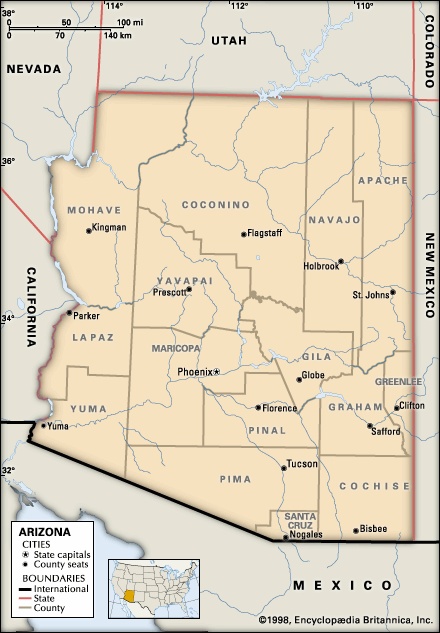
 The constitution of Arizona reflects the ideals of the Progressive movement, which was influential at the time of the constitutional convention in 1910. It provides for maximum citizen participation through initiatives and referenda on legislation and recall of all elected officials, including judges. A reorganization of the state government in 1968 strengthened the power of the governor and streamlined the executive branch. The governor is elected for a four-year term. The secretary of state, who succeeds to the governorship in case of a vacancy, holds the second most highly contested elective office in the state. Other members of the executive branch include the attorney general, the state treasurer, the superintendent of public instruction, the state mine inspector, and the five-member corporation commission, which oversees public service corporations.
The constitution of Arizona reflects the ideals of the Progressive movement, which was influential at the time of the constitutional convention in 1910. It provides for maximum citizen participation through initiatives and referenda on legislation and recall of all elected officials, including judges. A reorganization of the state government in 1968 strengthened the power of the governor and streamlined the executive branch. The governor is elected for a four-year term. The secretary of state, who succeeds to the governorship in case of a vacancy, holds the second most highly contested elective office in the state. Other members of the executive branch include the attorney general, the state treasurer, the superintendent of public instruction, the state mine inspector, and the five-member corporation commission, which oversees public service corporations.The legislature convenes annually and comprises a 60-member House of Representatives and a 30-member Senate; all members serve two-year terms. The massive growth of Phoenix and Tucson, combined with reapportionment, has given urbanized Maricopa and Pima counties some three-fourths of the seats in both chambers.
A constitutional amendment in 1960 restructured the judicial branch into the Supreme Court, the Court of Appeals, the Superior Courts, and local justice and other courts. Judges of the Supreme Court and the Court of Appeals are appointed by the governor from nominees chosen by a commission. Other judges are appointed or elected.
The 15 counties, acting as agents of the state, constitute the basic units of local government. State law prescribes the town type of government for settlements of fewer than 3,500 people and the city form for larger communities. Metropolitan centres have considerably more freedom in organization and operation.
Since the 1950s, Arizona has changed from what was traditionally a one-party state dominated by the Democrats to a system in which both major parties participate fully. Political dynamics, however, reflect conflicts between Maricopa county and the rest of the state more than any party differences. Republican (Republican Party) strength is centred in the Phoenix area, but the party also receives support from rural, conservative “Pinto” (i.e., “Spotted”) Democrats. Democratic (Democratic Party) factions continue to receive support in Flagstaff, Tucson, and some mining communities and among traditionally Democratic Mexican Americans and African Americans.
Health and welfare
The Arizona Department of Health Services, together with appointed boards, commissions, and councils, provides aid and inspection services, including a number of public health centres and hospitals. Private medical care in the metropolitan areas is excellent, but residents of rural areas and the reservations tend to receive substandard medical services. Despite its attractiveness to the ill and the aged, Arizona has no more than its per capita share of the nation's hospitals and nursing homes. The College of Medicine at the University of Arizona (Arizona, University of) and university-affiliated nursing programs work toward expanding the supply of medical personnel.
In 1981 the legislature created the controversial Arizona Health Care Cost Containment System Administration as an alternative to the federal Medicaid program. The system includes an insurance program designed to provide health care for those citizens who are indigent or who cannot otherwise afford adequate medical care. At the same time, it attempts to contain hospital and other medical costs. Arizona is the only state in the Union that does not participate in the Medicaid program, but it does receive some federal funding for its own system.
Unemployment and poverty rates tend to be high, which is partly attributable to poor economic conditions on Arizona's extensive Indian reservations and downturns in the agricultural and manufacturing sectors. Reforms applied since 1995 have limited assistance to the needy and have strengthened work requirements for eligibility, in keeping with the state's historically conservative approach to public welfare. The Department of Economic Security works mainly through county agencies with a variety of programs for children, the aged, and people with disabilities.
Education
Public education has struggled to meet the rapid increase in students accompanying the population boom and to cope with the overall lack of financial support from state government, which, in the late 20th century, was among those that spent the least per capita on public education. Children must attend school between the ages of 8 and 16 or until graduation from the eighth grade. This law is irregularly enforced, however, and the state's dropout rate has been among the highest in the country. Elementary, secondary, and consolidated districts operate with the assistance of county and state superintendents and an appointed state Board of Education.
Higher education in Arizona, as in most western states, is dominated by large public universities. The Arizona Board of Regents assumes responsibility for the University of Arizona (founded 1885) in Tucson, Arizona State University (1885) in Tempe, and Northern Arizona University (1899) in Flagstaff. The state community college system encompasses dozens of campuses, branch centres, and skill centres across the state. Arizona has few private colleges.
Cultural life
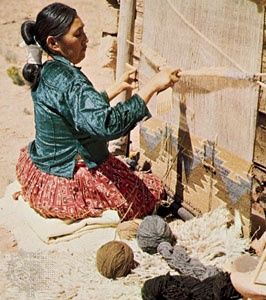
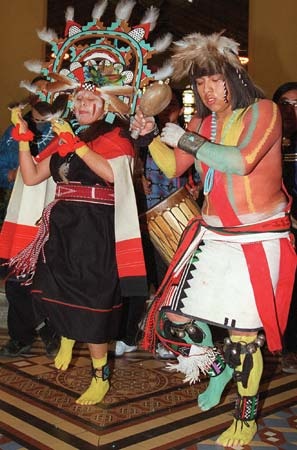 Although traditionally a centre for Native American folk arts and crafts, Arizona has had no circles of painters and writers comparable to those of neighbouring New Mexico. Interest in painting, crafts, drama, music, and publishing, however, has increased with population growth. Architecture and the graphic arts have been particularly influenced by Southwestern regional themes. Few of the state's artists are native born. Among its best-known writers are Zane Grey (Grey, Zane), Edward Abbey (Abbey, Edward), and Barbara Kingsolver (Kingsolver, Barbara). A few native-born writers of the 20th century, such as Marguerite Noble, Alberto Ríos, and Eva Antonia Wilbur-Cruce, contributed to a genre that emphasizes the real hardships of the region along with its austere beauty. Contemporary Native American writers active in the state—though most were born outside Arizona—include Leslie Marmon Silko (Silko, Leslie Marmon), N. Scott Momaday (Momaday, N. Scott), Luci Tapahonso, Laura Tohe, Simon Ortiz, and Ofelia Zepeda.
Although traditionally a centre for Native American folk arts and crafts, Arizona has had no circles of painters and writers comparable to those of neighbouring New Mexico. Interest in painting, crafts, drama, music, and publishing, however, has increased with population growth. Architecture and the graphic arts have been particularly influenced by Southwestern regional themes. Few of the state's artists are native born. Among its best-known writers are Zane Grey (Grey, Zane), Edward Abbey (Abbey, Edward), and Barbara Kingsolver (Kingsolver, Barbara). A few native-born writers of the 20th century, such as Marguerite Noble, Alberto Ríos, and Eva Antonia Wilbur-Cruce, contributed to a genre that emphasizes the real hardships of the region along with its austere beauty. Contemporary Native American writers active in the state—though most were born outside Arizona—include Leslie Marmon Silko (Silko, Leslie Marmon), N. Scott Momaday (Momaday, N. Scott), Luci Tapahonso, Laura Tohe, Simon Ortiz, and Ofelia Zepeda.Contemporary Native American arts and crafts, executed within the traditions of the tribes, receive worldwide praise. In particular, Hopi and Navajo painters, silver and jewelry craftsmen, weavers, basketmakers, and potters produce a high volume of much-desired and expensive work.
No city dominates as an art centre, although Scottsdale, Tucson, Sedona, and Tubac have colonies of working artists. Flagstaff and Tucson are home to a number of well-respected photographers. The Phoenix Art Museum has permanent collections of Western American, Asian, Latin American, and European art, as well as a fashion design collection. The Arizona State Museum at the University of Arizona in Tucson, the Heard Museum in Phoenix, the Sharlot Hall Museum in Prescott, and the Museum of Northern Arizona in Flagstaff feature archaeological and traditional collections of Indian arts and crafts. Symphony orchestras, theatres, ballets, and opera are well supported in Phoenix and Tucson.
 More than any other art form, architecture embodies the relationship between the regional traditions of the Southwest and modern international trends. Several fine examples of Frank Lloyd Wright (Wright, Frank Lloyd)'s work—including his home at Taliesin West (Taliesin and Taliesin West)—and the futuristic, embryonic city of Arcosanti designed by Paolo Soleri (Soleri, Paolo) are found in Arizona. Among the many structures in the Spanish style, the Heard Museum is outstanding, and the Nogales Public Library synthesizes the Spanish Southwestern and contemporary styles. Probably the most photographed building in all of Arizona is the San Xavier del Bac Mission (popularly called the “White Dove of the Desert”), located near Tucson and completed by the Franciscans in 1797.
More than any other art form, architecture embodies the relationship between the regional traditions of the Southwest and modern international trends. Several fine examples of Frank Lloyd Wright (Wright, Frank Lloyd)'s work—including his home at Taliesin West (Taliesin and Taliesin West)—and the futuristic, embryonic city of Arcosanti designed by Paolo Soleri (Soleri, Paolo) are found in Arizona. Among the many structures in the Spanish style, the Heard Museum is outstanding, and the Nogales Public Library synthesizes the Spanish Southwestern and contemporary styles. Probably the most photographed building in all of Arizona is the San Xavier del Bac Mission (popularly called the “White Dove of the Desert”), located near Tucson and completed by the Franciscans in 1797.The state's leading book publisher, the University of Arizona Press, releases a variety of scholarly and popular titles, most with a Southwestern focus. The Arizona Historical Society also supports a journal- and book-publishing program. The state's most widely known publication, Arizona Highways, brings varied features of Arizona to a worldwide audience. The daily Arizona Republic and weekly New Times, published in Phoenix, are popular sources of news and editorials.
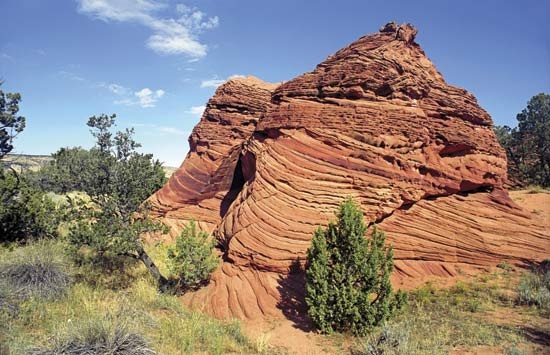 A variety of sports and recreational activities provide entertainment and leisure. Professional sports teams include the Arizona Cardinals (gridiron football), Phoenix Suns (men's basketball), Arizona Diamondbacks (baseball), Phoenix Coyotes (hockey), and Phoenix Mercury (women's basketball). Varied desert and forest terrains and many man-made lakes attract thousands of hunting and fishing enthusiasts, campers, hikers, and amateur prospectors and historians throughout the year. Arizona has more national parks—notably, Grand Canyon, Saguaro (Saguaro National Park), and Petrified Forest (Petrified Forest National Park) (part of the Painted Desert)—and monuments—including Chiricahua (Chiricahua National Monument), Montezuma Castle (Montezuma Castle National Monument), and Organ Pipe Cactus (Organ Pipe Cactus National Monument)—than any other state. The Arizona–Sonora Desert Museum (Arizona-Sonora Desert Museum) near Tucson has received worldwide attention as a living museum dedicated to the natural world of the Sonoran Desert. Rodeos take place in the cities and on the larger Native American reservations. Many towns and cities sponsor festivals, among them Helldorado Days in Tombstone, Rex Allen Day in Willcox, and the White Mountain Festival in Pinetop.
A variety of sports and recreational activities provide entertainment and leisure. Professional sports teams include the Arizona Cardinals (gridiron football), Phoenix Suns (men's basketball), Arizona Diamondbacks (baseball), Phoenix Coyotes (hockey), and Phoenix Mercury (women's basketball). Varied desert and forest terrains and many man-made lakes attract thousands of hunting and fishing enthusiasts, campers, hikers, and amateur prospectors and historians throughout the year. Arizona has more national parks—notably, Grand Canyon, Saguaro (Saguaro National Park), and Petrified Forest (Petrified Forest National Park) (part of the Painted Desert)—and monuments—including Chiricahua (Chiricahua National Monument), Montezuma Castle (Montezuma Castle National Monument), and Organ Pipe Cactus (Organ Pipe Cactus National Monument)—than any other state. The Arizona–Sonora Desert Museum (Arizona-Sonora Desert Museum) near Tucson has received worldwide attention as a living museum dedicated to the natural world of the Sonoran Desert. Rodeos take place in the cities and on the larger Native American reservations. Many towns and cities sponsor festivals, among them Helldorado Days in Tombstone, Rex Allen Day in Willcox, and the White Mountain Festival in Pinetop.History (Arizona)
Early settlement
Prehistoric peoples
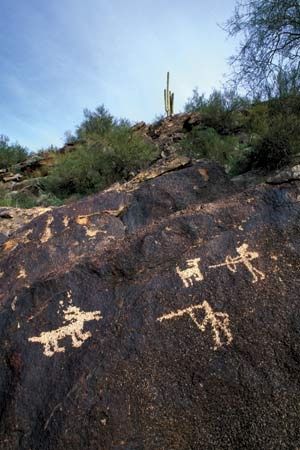 Although the region's physical environment may appear inhospitable to habitation and subsistence, Arizona contains some of North America's oldest records of human occupation. Relics of material culture are evidence that humans most likely lived in Arizona more than 25,000 years ago. For most of this prehistoric period, those people lived in caves and hunted animals, many species of which no longer exist. Scholars believe that the Cochise culture, made up of people living in what is now southeastern Arizona, began more than 10,000 years ago and lasted until 500 BC or later.
Although the region's physical environment may appear inhospitable to habitation and subsistence, Arizona contains some of North America's oldest records of human occupation. Relics of material culture are evidence that humans most likely lived in Arizona more than 25,000 years ago. For most of this prehistoric period, those people lived in caves and hunted animals, many species of which no longer exist. Scholars believe that the Cochise culture, made up of people living in what is now southeastern Arizona, began more than 10,000 years ago and lasted until 500 BC or later.During the past 2,000 years, the prehistoric societies that developed within Arizona were highly organized and advanced. Many of these Native American groups lived in durable masonry villages called pueblo (pueblo architecture)s (from the Spanish word meaning “town” or “village”). Arizona has become one of the most intensively excavated parts of the New World for archaeological research on this period. This group of prehistoric cultures, which are better known than their predecessors, includes the Hohokam (Hohokam culture), Ancestral Pueblo (Anasazi), Mogollon (Mogollon culture), Sinagua, Salado, Cohonina, and Patayan. The nomadic Apache and Navajo probably arrived in the region some time between AD 1100 and 1500.
The Spanish period
The documented record of the European explorers and settlers of the region began in Mexico in the 1530s with Spaniards who wrote about the legend of Eldorado and the Seven Golden Cities of Cíbola (Cíbola, Seven Cities of). In 1539 Fray Marcos de Niza (Niza, Marcos de), a Franciscan priest, entered Arizona in search of riches and hoping to find Native Americans to convert to Christianity. Fearful of the hostility he faced from the indigenous people, Fray Marcos returned to Mexico and reported misleadingly about the places he visited. The following year Francisco Vázquez de Coronado (Coronado, Francisco Vázquez de) led a large well-armed expedition to Arizona in an effort to claim for Spain what is known today as the American Southwest. In contrast to Marcos's reports, Coronado wrote favorably of the area, notably to the ruler of New Spain (New Spain, Viceroyalty of), Viceroy Mendoza. Members of Coronado's expedition visited the Grand Canyon and the Hopi pueblos, while Coronado himself traveled as far as eastern Kansas before returning to Mexico.
In 1583 members of the Hopi tribe guided the Spanish explorer Antonio de Espejo to the site of present-day Jerome. He was disappointed to find copper and other nonprecious metal ores instead of the gold he sought. By 1675 several Franciscan missionaries had established themselves at the Hopi villages, but five years later the Hopi rose up and drove the Spaniards out as part of the regionwide Pueblo Rebellion. In the early 1700s Roman Catholic missionaries established churches in the upper Santa Cruz valley in southern Arizona. During that period other Hispanics also settled there but were confined to the valley by Apache raiders. In the 18th century priests visited various parts of northern Arizona, including the Hopi villages, but made no serious attempt at religious conversion.
After the successful revolution that brought Mexico's independence from Spain in 1821, the new government ordered the missions in Arizona to close. Arizona was ceded to the United States as part of New Mexico in 1848; it became independent of New Mexico in 1863. Following the Gadsden Purchase in 1853, when Mexico sold Arizona's southernmost region to the United States, only a few scattered and isolated Mexican American ranches remained, all of them located near the Mexican border.
Statehood and growth
Until the Mexican-American War (1846–48), only a few Americans—explorers, soldiers, trappers, sheep drivers—had visited Arizona. In 1851 the U.S. Army Corps of Engineers sent several expeditions into Arizona to find a suitable route on which to build a wagon road to California. To protect travelers, miners, and other settlers from Native Americans, the U.S. government began to locate army posts at key sites. In 1883, workers completed the Atchison, Topeka and Santa Fe Railway (Atchison, Topeka and Santa Fe Railway Company, The) across northern Arizona, thereby linking St. Louis (Saint Louis), Mo., with California; that same year the Southern Pacific Railroad completed a line from New Orleans to Los Angeles by way of Tucson and Yuma.
The copper era
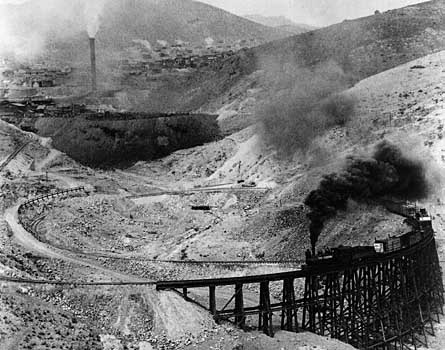 Copper, Arizona's premier industry until the 1950s, was first mined in Arizona at Ajo in 1854. The Planet mines opened on the banks of the Colorado River about the same time. By 1876 the Clifton-Morenci district in eastern Arizona had two large-scale mining operations. Copper mines in Globe and Jerome, both in central Arizona, also developed rapidly, as did the silver mines at Tombstone. However, the richest copper find of all occurred in 1877 in Bisbee, in southeastern Arizona near the Mexican border. By 1880 national and international advances in electrical engineering and the availability of investment capital had created a vigorous demand for copper, and Arizona began to satisfy a rapidly growing market; the state still mines and processes about two-thirds of the copper produced in the United States.
Copper, Arizona's premier industry until the 1950s, was first mined in Arizona at Ajo in 1854. The Planet mines opened on the banks of the Colorado River about the same time. By 1876 the Clifton-Morenci district in eastern Arizona had two large-scale mining operations. Copper mines in Globe and Jerome, both in central Arizona, also developed rapidly, as did the silver mines at Tombstone. However, the richest copper find of all occurred in 1877 in Bisbee, in southeastern Arizona near the Mexican border. By 1880 national and international advances in electrical engineering and the availability of investment capital had created a vigorous demand for copper, and Arizona began to satisfy a rapidly growing market; the state still mines and processes about two-thirds of the copper produced in the United States.Development of commercial agriculture
During the 1870s a few homesteaders, including a number of Mormon immigrants from Utah, attempted to develop farming economies along Arizona's few streams and rivers. Droughts, floods, and the need for heavy capital investment made it clear that for commercial farming to succeed in the state it would have to be practiced on a large scale, be highly organized, and use the best technology available. To do this, central Arizona agricultural interests developed plans for large water-storage and flood-control systems that included expensive dams and extensive canal systems. The Salt River Project, completed in 1911, delivered water to farmers in the Phoenix area (now the state's agricultural heartland). Water shortages continued to plague the state, however, and in 1963, after a long and bitter fight with California, Arizona obtained a ruling by the U.S. Supreme Court that affirmed Arizona's right to some 2.8 million acre-feet (3.5 billion square metres) of water annually from the Colorado River, as well as the entire flow of the Gila River. In 1968, after a lengthy and heated debate, the U.S. Congress authorized the Central Arizona Project, a massive system of pumps and canals to conduct water from the Colorado River to the Phoenix and Tucson areas; the project was completed in 1993.
Range cattle constituted a major source of income for Arizona from the 1860s until World War II, when large feedlots became prominent. Those lots, in turn, have begun to disappear; today the cattle raised in Arizona constitute only a small percentage of the country's edible beef.
Population influx
After Arizona achieved statehood in 1912, it soon began to tout itself as the place of the “five Cs”: copper, cattle, cotton, citrus, and climate. Health seekers from the rest of the country discovered that the clear, clean, dry air of Arizona brought relief from various respiratory ailments, thus laying the foundation for a growing stream of in-migrants and visitors who continued to infuse money into the state. During the 1920s “motor courts” (motels), dude ranches, and resorts sprang up to accommodate increasing numbers of tourists, winter residents, and retirees. Arizona, with its favourable climate and its distance from the country's coasts, became the site of several World War II flight schools and other U.S. government military bases. Following the war, a surge of migration from other states—particularly from the Midwest—changed Phoenix into one of the fastest-growing urban areas in the United States. Also of great significance was the development and widespread use of refrigeration and air conditioning, which perhaps more than anything else made Arizona attractive and habitable.
Many people think of the state as a romantic getaway fraught with images of Native Americans, cowboys, and a Mexican “mañana” atmosphere. Arizona, however, has never been free from the curses of an urban industrial society. Were it not for such technological developments as railroads, copper smelters, nuclear reactors, automobiles, refrigeration, computers, and hydroelectric turbines, few people would be living in the state today.
Although many newcomers anticipate a land of personal fulfillment, the state has its share of disillusioning characteristics—for example, notably high rates of bankruptcy, crime, and divorce. It faces the challenge of balancing a modern society built in an arid land with the preservation of as much as possible of its beautiful natural landscape. Arizona's major problem is the limit of the state's ability to support a growing population in a way that does not bring deterioration to those characteristics that made Arizona attractive in the first place.
Additional Reading
Geographic studies include Malcolm L. Comeaux, Arizona (1981); University of Arizona, Arizona: Its People and Resources, rev. 2nd ed. (1972); and Tom Miller (ed.), Arizona: The Land and the People (1986). The history of Arizona is provided by Thomas E. Sheridan, Arizona: A History (1995); Marshall Trimble, Arizona (1977); Lawrence Clark Powell, Arizona (1976); and Jay J. Wagoner, Early Arizona: Prehistory to Civil War (1975), and Arizona Territory, 1863–1912 (1970). Still a good source for the state's early history is Thomas Edwin Farish, History of Arizona, 8 vol. (1915–18).The series of guides written under the Works Progress Administration is an excellent source for information about many aspects of each state; many of these guides have been reprinted or revised. State atlases and historical atlases present graphically the settlement, development, and current condition of each state. Statistical abstracts and state yearbooks or directories (“blue books”) are the best sources for data and for information on the political organization of each state. The triennial fact books for each state, published by Clements Research, give comprehensive county-by-county coverage—e.g., Illinois Facts. Books about place-names in each state provide information on local history. Volumes in The States and the Nation Series provide good historical introductions. State historical journals publish current historical research.
- Ralph Modjeski
- Ralph Nader
- Ralph Of Coggeshall
- Ralph Randolph Gurley
- Ralph Shapey
- Ralph Tyler Flewelling
- Ralph Van Deman
- Ralph Vaughan Williams
- Ralph Waldo Emerson
- Ralph Walter Graystone Wyckoff
- Ralston Purina Company
- ram
- Rama
- Ramadier, Paul
- Rama I
- Rama II
- Rama III
- Ramakrishna
- Ramakrishna Mission
- Ramallah
- Ramana Maharshi
- Ramananda
- Ramanathapuram
- Raman effect
- Raman, Sir Chandrasekhara Venkata